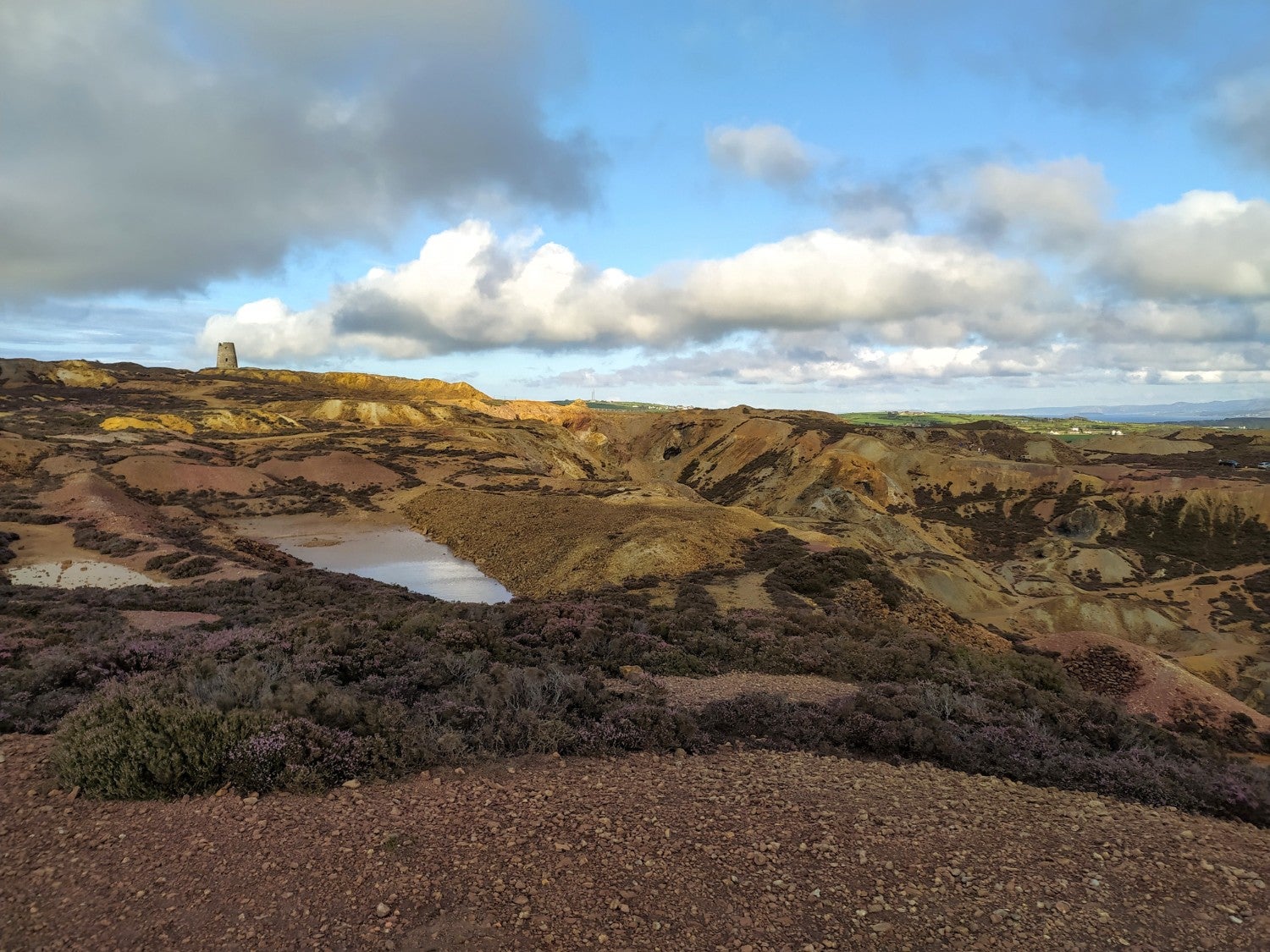A ‘Mars’ walk on Anglesey: Exploring Parys Mountain’s rugged landscape
Amy Briscoe discovers an otherworldly spot in the north of Wales


After the suffocation of lockdown, and the ubiquity of face masks and sanitiser, the real world felt unfamiliar and no longer a safe place to retreat to.
A salubrious wander in the Anglesey countryside with a coastal view felt like the best we could hope for. So on our first outing after the restrictions of lockdown, we were not expecting to be captivated by the otherworldly charm of Parys Mountain.
In fact, we weren’t entirely sure we were on the right trail as we approached the site; there were no signposts, but this only added to its elusive charm.
Rusty brown rocks and a tall grey structure in the distance eventually led us to an entrance off a empty main road.
Parys Mountain, located in northeast Anglesey, near the sleepy fishing town of Amlwch, has only allowed the public inside to admire its faded industrial glory and geological gems in the past few years.
The existence of the site has been passed on through word of mouth, local-to-local, meaning that it’s still relatively empty of tourists. But Mynydd Parys, as it is known in the ancient tongue of Welsh, has seen flurries of interest throughout history.
It was mined as long ago as the bronze age, then by the Romans. Following “The Great Discovery” in 1768, when a local miner stumbled on a large deposit of copper ore, people flocked here from all over the UK hoping to make their fortune. The copper from here even coated the warships of the Royal Navy at the Battle of Trafalgar in 1805.
The mountain held the title of “The Copper Kingdom” because it was the biggest copper mine in the world. Relics of industrial history, combined with a dazzling copper landscape, means it now looks like something straight out of a science fiction film – Doctor Who was filmed here, after all.
At first glance, it looks surreal, empty and almost post-apocalyptic in the most compelling way. It’s far from what you might associate with the wild walks and challenging treks across the Menai Strait in Snowdonia. As soon as you enter the site, you’re struck by the contrast between the green farmland surrounding it and the mounds of rust and gold rocks glimmering in the sun.
Our kids ran into the space at full sprint, eager to examine the rocks all around them as if they had just discovered an Aladdin's cave of the most unusual geology. It was like we had escaped the world of Covid-19 and voyaged to another planet.
Lavender and gorse have bound themselves to the landscape, while small offshoots from the main route expanded like a spider’s web. Some of the paths required a gentle scramble over rocks, but that only added to the adventure of the place.
A palpable air of mystery and intrigue as to what you could discover at the end of one of these paths hung over the site. “There might be a bear inside... or an alien,” my son Louis pondered out loud as he spotted a subterranean cave.
It’s impossible to miss Parys Mountain Windmill, though, as it sticks out of the mountaintop like an open wound, commanding attention from miles around. According to The Royal Commission on the Ancient and Historical Monuments of Wales, it crowns the mountain’s highest point, and reaches an impressive 138 metres above sea level.
The windmill’s role was to pump water out of the mountain, remove the mined ore and even lift machinery from mine shafts deep beneath the mountain.
A marvel of engineering from Wales' industrial past, it was the last tower windmill built in the country, and the only windmill on Anglesey to bear five sails, rather than the usual four, demonstrating the important role it played in the success of the mine.
It continued to turn until the closure of the site in 1904 and has served its role as a solitary shell overlooking Anglesey ever since.Inside, there is a large basement level full of boulders, and on the upper level is a wooden walkway from which you can peer out of tiny windows onto the sublime Anglesey landscape with the Carneddau mountains in the distance.
Other remnants of industrial ruins litter the walk. If you look closely, you can spot rickety wooden doors and quaint outbuildings concealed among walls of rock and the odd tiny cave entrance.
We walked down a winding path behind the windmill to a large open area reminiscent of the views often seen at the Grand Canyon. My daughter Sofia, excited by the view, exclaimed: “It looks just like a canyon and we are exploring Mars!”
Indeed, it’s probably the closest you’ll get to a view of Mars in the UK.
As we ventured further down into the mountain itself, the children made their most exciting discovery of the day – a large cave at the bottom of the quarry. Inside, behind a large pool of water and darkness, there was a mysterious door that kept the children guessing for the rest of the day.
Parys Mountain gave the children a chance to explore a whole new fantastical environment without the boundaries of four walls. Its emptiness and isolation meant we could freely explore another world for a whole two hours, free from the constraints of Covid-19.
As we walked away, I was left with the sudden realisation that the rugged, dazzling landscape of Parys Mountain won't be here forever and, as nature reclaims it, we probably won't be able to see and touch the vividly coloured rocks for much longer.
Join our commenting forum
Join thought-provoking conversations, follow other Independent readers and see their replies
Comments

Bookmark popover
Removed from bookmarks